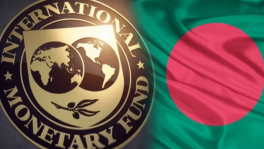Should Bangladesh reshape its power system?
Bangladesh’s electricity system can integrate a higher share of renewables, but it requires investment towards infrastructure development, specifically for grid upgradation

This decade presents a "now-or-never" opportunity to limit global warming to 1.5 degree Celsius above pre-industrial levels. The sixth assessment report of the Intergovernmental Panel on Climate Change (IPCC) shows that limiting global temperature rise to 1.5 degree Celsius by the end of the century is still possible, but it will require rapid emission reduction initiatives.
On the eve of the world leaders' gathering for COP26, the "State of the Climate Action 2021" report revealed that the transition required to avoid the worst of the climate impacts are not happening fast enough.
Out of the 40 climate indicators in the sectors of power, industry, transport, agriculture, buildings, finance, technological carbon removal, land use and coastal zone management, none are on track to reach the 2030 targets. Only eight indicators are heading into the right direction at a promising but at an insufficient pace.
Among the eight promising indicators, the power sector indicator of increasing the global share of electricity generated by renewable sources has increased, primarily due to the contribution of the advanced economies.
Building new solar and wind energy capacity is now more cost-effective than ever, which is evident from the average growth rate of 15% per year from these two technologies since 2015.
Despite these promising signs, the global share of electricity generated by renewable energy sources still needs to increase from 29% in 2020 to 55-90% by 2030 to meet the transition target.
The rapid transition to renewables cannot be achieved without participation of developing and emerging economies. The COP26 has seen the launch of Global Energy Alliance for People and Planet (GEAPP), a joint initiative by the IKEA Foundation, The Rockefeller Foundation and Bezos Earth Fund to accelerate investment in green energy transitions and renewable power solutions.
GEAPP in its report "Transforming the Power System in Energy-Poor Countries" has analysed the power system of 81 developing and emerging countries that are home to nearly half of the world's population. Presently these 81 countries contribute only 8% of the CO2 to the atmosphere that is causing global warming.
However, if these countries' power systems are not decarbonised, their share in global emission could grow to 75% by 2050, considering their rapidly growing economies. Transition to clean energy solutions in these countries would require concessional climate financing support. However, these countries presently receive only 13% of the clean energy financing.

Bangladesh is one of the countries included in the GEAPP report whose transformed power system presents an opportunity to promote the well-being of its population while tackling the climate crisis.
As the eighth most populous country of the world with present installed capacity of around 20 GW, it is estimated that the energy demand will reach around 50 GW by 2041. Bangladesh submitted its updated Nationally Determined Contribution (NDC) in August 2021 where, with international financial and technical support, Bangladesh committed to implement renewable energy projects with installed capacity of 4,114 MW by 2030.
Bangladesh has been seeing increased interest in renewables in recent years. In a COP26 policy brief by the UK's Climate Compatible Growth Programme, it was observed that beneficiaries in rural Bangladesh preferred renewable energy-based systems over grid electricity and they are staying linked with renewable energy systems despite receiving electricity from the grid.
The government of Bangladesh is drawing up an ambitious Climate Prosperity Plan named after the Father of the Nation, Bangabandhu Sheikh Mujibur Rahman, which is expected to mobilise financial resources for implementing renewable energy projects with increased focus in reinforcing power grid stability.
Among the renewable energy resources in Bangladesh, solar is the primary source accounting for 70% of the total renewable energy generation of the country. In addition to solar, in the Mujib Climate Prosperity Plan along with the Eighth five-year plan up to 2025 and in the updated NDC, an increased focus has been given on wind energy.
Bangladesh also can explore geothermal energy by utilising the existing infrastructure of the depleting natural gas wells. A team of researchers led by Joyashree Roy from the Asian Institute of Technology has made a case by collecting data from three wells in the Kailashtila gas field for their potential as a geothermal energy source, which can be further assessed.
In COP26, Bangladesh can seek technology transfer support from the developed nations to implement these initiatives. Germany is one of the most advanced economies where wind energy is one of the major sources of electricity generation. In 2020, wind had a total share of 27% in Germany's total electricity production with an installed capacity around 54 GW.
Germany has been providing low cost financial and technical support to Bangladesh since 1972 for technology transfer, capacity building and implementation of renewable energy projects. Further collaboration for installation of wind energy production facilities in different suitable locations of Bangladesh may be negotiated with Germany and other European countries.
Bangladesh's electricity system can integrate a higher share of renewables, but it requires investment towards infrastructure development specifically for grid upgradation. As a climate vulnerable country, a key message that Bangladesh can raise to the richest nations in COP26 is to support Bangladesh towards a climate-safe pathway towards a grid-based clean energy transition.
Md Mosharraf Hossain Bhuiyan is the Ambassador of Bangladesh in Germany and Former Chairman, National Board of Revenue.
Ashraf Hossain Bhuiyan is AVP at Infrastructure Development Company Limited.
Disclaimer: The views and opinions expressed in this article are those of the authors and do not necessarily reflect the opinions and views of The Business Standard.


 Keep updated, follow The Business Standard's Google news channel
Keep updated, follow The Business Standard's Google news channel














